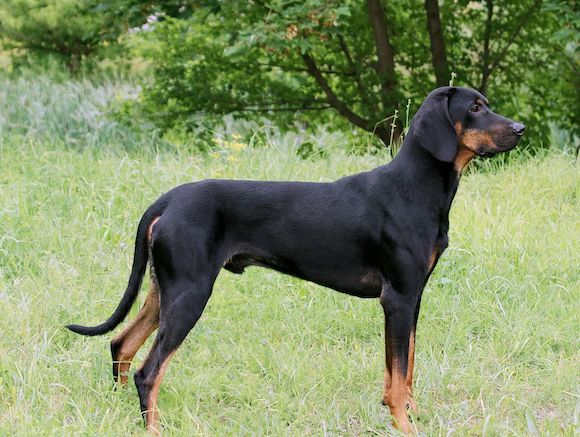
Poles have been hunting with scent hounds since the 13th century, and in 14th century chronicles, it was noted that Polish nobility especially valued the dogs. By the 17th century, two different types of scent hounds in Poland were known, but it wasn’t until 1819 that Jan Szytier described them in his Poradnik Mysliwych (Hunting Guide): The Polish “brach,”was a heavier hound, while the other scenthound was lighter. That lighter dog was the ancestor of today’s Gonczy Polski, or Polish Hunting Hound. At the time, however, the Polish Hound and the Polish Hunting Dog were considered to be one breed with two types.
Even after World War I, hunting with Polish hounds flourished in the deeply wooded areas of eastern Poland and the southern mountains, but breed numbers had been impacted by the war. Old families who had always had the dogs kept them from vanishing, and Józef Pawlusiewicz’s family was one of them. Pawlusiewicz had inherited hounds from his father, and long before the next world war came along, he was working to shore up breed stability by seeking out suitable dogs owned by other hunters for his breeding program under the “z Karpat” kennel name. As it happened, Pawuslewicz was a noted Polish cynologist; he wrote the first real breed standard, and worked to get the dogs officially recognized by the Polish Cynological Association.
All was not smooth sailing, however.
Around the same time that Pawlusiewicz was breeding his hounds, Col. Piotr Kartawik had his own breeding program using hounds he’d brought from his family home in Belarus to Poland. Compared to Pawlusiewicz’s dogs, Kartawik’s dogs were big, heavier boned, and stoutly built. In 1966, the “Kartawik type” was recognized by the FCI as the “the Polish Hound,” and Pawlusiewicz’s hounds – smaller and with different coat colour, didn’t meet requirements of that standard. Pawlusiewicz’s dogs couldn’t be registered, and thus were disqualified at dog shows. Worse, they were considered mutts.
Not so in the minds of the hunters who appreciated Pawlusiewicz’s hounds for their outstanding skills at wild boar hunting and tracking wounded game. Gonczy Polski breeders still kept them, but without documentation.
Biometric measurements conducted in Warsaw in 1968, and later between 1982 and 1983 proved that these dogs were not one breed with two types, but two different breeds. Still, one supposes that the temptation to breed the two hounds together was too great to resist, and until 1982, that’s exactly what was happening. The results weren’t good.
In 1983, the Polish Kennel Club opened the stud book for the excluded group of dogs under the name, Gończy Polski, and a breed standard was drawn up by Dr. Kazimierz Ściesiński. It took several years to undo what had been done with earlier cross-breedings, but perseverance paid off. The first Gończy pedigrees were issued in 1989. In 2006, the breed was provisionally recognized by the FCI. Now Polish Hunting Dogs are considered to be one of Poland’s five national dog breeds, and they are more numerous than Polish Hounds!
One reason for the breed’s popularity over the Polish Hound is its temperament. Though this is still a working breed that needs to be physically active, it is a stable and gentle breed. He is a hound in every sense (read: he gives voice) and as such, hunters rather like the melodious barking that changes pitch during the chase. They find pleasure in watching the breed’s effortless, fluid and long reaching gait, and they enjoy the breed’s “off switch” that enables a good cuddle at the end of the day.
Today, the breed is rarely seen outside Poland where it’s been kept almost completely by hunters, but this is changing. Polish Hunting Dogs are increasingly being seen at dog shows (to become a Polish champion, the Gończy Polski must also have a working certificate), and in agility and flyball events where they excel. Families are also discovering the marvelous companionship of this intelligent breed.
Image of a Polish Hunting Hound by Янковский Евгений via Wikicommons
